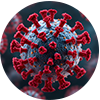
Pollen allergy is one of the most common allergies. The lowest prevalence of pollen allergy is in early childhood (up to 5 years), then rises sharply and reaches a maximum in adolescence and early adulthood.
Allergy is an inadequate response of the immune system to normal external stimuli. During this exaggerated reaction, a chain cascade of immune reactions is activated in the body, which is accompanied by the release of histamine and other chemicals (mediators) into the bloodstream. The reaction site is infiltrated by the inflammatory cells and allergic inflammation develops.
The clinical manifestations are:
In the Czech Republic, we distinguish three specific periods when different types of allergens dominate:
Regime measures:
The most important thing is to keep contact with allergens to a minimum.
Regime measures include:
It is worth following the pollen calendar (information on flowering time) and current pollen news (weekly monitoring of pollen in the air).
Pharmacological treatment:
The most commonly used group of drugs are the so-called. antihistamines (available in the form of tablets, eye drops, etc.) and most patients take them regularly throughout the pollen season. Some of them are subject to a prescription and others are over-the-counter. Antihistamines are often combined with nasal (topical) corticosteroids for best results. It can also be supplemented with decongestants (they improve the patency of a stuffy nose).
Freely according to the ČLnK web portal for the public Lékárnické drops, 25.5.2022

4. 12. 2025
The pitfalls of mail order dispensingAt the recent XXXIVth congress of delegates of the Czech Chamber of Pharmacists, the discussion about the possibility of introducing mail order dispensing was reopened ...

31. 10. 2025
Hepatitis A (viral hepatitis A) is an infectious inflammatory liver disease caused by the hepatitis A virus. It is transmitted by the fecal-oral route either by ...